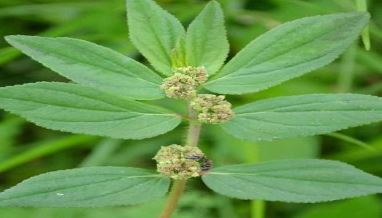An Invitro study to evaluate the Krimighna Karma (Antimicrobial Activity) of Dugdhika Patra (Euphorbia hirta Linn.) against Staphyloccus aureus
DOI:
https://doi.org/10.21760/jaims.9.10.5Keywords:
Dugdhika, Krimighna, Swarasa, Staphylococcus aureus, Zone of inhibition, AntibacterialAbstract
Background: Today’s world’s mortality rate depends on the infectious diseases and accounts for about 50% of all deaths. Deadly diseases of this century were mainly caused by bacterial infections. Biologically important plants were discovered by evaluation of ethnopharmacological data and they are locally populated with immediate therapeutic action. The recognition of any of the Dravya is through its Karma (Action). The Karma is mainly explained with the help of Rasa Panchaka in science of Ayurveda. Krimighna Karma is one such Karma which is responsible for the destruction of the Krimi. The plant Dugdhika is widely used in traditional medicine to cure various diseases, especially gastrointestinal disorders, respiratory disorders and skin disorders. Aim: To evaluate the Krimighna Karma of Dugdhika Patra Swarasa against Staphylococcus aureus bacteria. Materials and Methods: In this study, Dugdhika Patra (Euphorbia hirta Linn.) Swarasa was evaluated for its antibacterial activity against Staphylococcus aureus bacteria using well diffusion method. Observations and Results: The zone of inhibition was observed through agar well diffusion method. Swarasa had shown maximum Zone of inhibition (9mm) for Staphylococcus aureus bacteria when dispensed directly and moderate zone of inhibition (6mm) with diluted concentration after 24 hours of incubation period when compared to control group but not as that of standard group. These findings established the potential of Dugdhika Patra Swarasa has effective antibacterial agent against Staphylococcus aureus. However, further studies are needed to evaluate the active compounds and probable medicinal benefits in humans by clinical trials.
Downloads
References
Hoareau L, DaSilva EJ (1999). Medicinal plants: a re-emerging health aid. Electronic J. Biotechnol., 2: 56-70.)
Seth SD, Sharma B (2004). Medicinal plants in India. Indian J. Med. Res., 120: 09-11
Seddik K, Nadjet I, Abderrahmane B, Daud H, Lekhmici A (2010). Antioxidant and antibacterial activities of extracts from Artemisia herba alba Asso. leaves and some phenolic compounds. J. Med. Plant Res., 4: 1273-1280)
Eloff JN, Famakin JO, Katerere DRP (2005). Combretum woodii (Combretaceae) leaf extracts have high activity against Gram negative and Gram-positive bacteria. Afr. J. Biotechnol., 4: 1161- 1166.
Adekunle AS, Adekunle OC (2009). Preliminary assessment of antimicrobial properties of aqueous extract of plants against infectious diseases. Biol. Med., 1: 20-24.
Madigan MT, Martinko JM, Bender KS, Buckley DH, Stahl DA, Brock TD. Brock Biology of Microorganisms. 14th ed. San Francisco: Benjamin Cummings; 2014. Chapter 15, Diversity of Bacteria;p.517.
Mohan H. Textbook of Pathology. 8th ed. New Delhi: Jaypee Brothers Medical Publishers Pvt, Ltd.; 2019. Chapter 7, Infections and parasitic disease ;p. 179. ISBN: 9789352705474
https://www.ncbi.nlm.nih.gov/books/NBK459173/
Madigan MT, Martinko JM, Bender KS, Buckley DH, Stahl DA, Brock TD. Brock Biology of Microorganisms. 14th ed. San Francisco: Benjamin Cummings; 2014. Chapter 23, Microbial interactions with Humans ;p.735.
Vinay Kumar, Abul K. Abbas, Jon C. Aster. Robbins and Cotran Pathologic Basis of Disease. 10th ed. South Asia: Elsevier Health Sciences; 2020. Chapter 8, Infectious diseases; p 357
Huang, L., Chen, S. and Yang, M. 2012. Euphorbia hirta (Feiyangcao): A review on its ethnopharmacology, phytochemistry and pharmacology. Journal of Medicinal Plants Research. 6(39):5176-5185.
Sharma PV, Sharma GP, Kaiyadeva Nighantu, ed.1, Aushadhi varga,1979. Varanasi, Chaukhambha Orientalia; p. 129
CCRAS, Database on Medicinal Plants Used in Ayurveda and Siddha, Vol 5, New Delhi, p. 68-71
Vidyanath R, Illustrated Ashtanga Hridaya of Vagbhata, ed.1, Sutrasthana, Rasabhedeeya Adhyaya, Chapter 10, verse no. 14-19. Varanasi, Chaukhambha Surbharati Pratisthan; p.176
Acharya YT, Sushruta Samhita of Sushruta with Nibandha sangraha tika of Sri Dalhanacharya, Sutrasthana, Chapter 42: Rasavishesha vijnaneeya Adhyaya, Verse No. 4-5, 1992. Varanasi, Chaukhambha Sanskrit Sansthan; p.186
Acharya YT, Sushruta Samhita of Sushruta with Nibandha sangraha tika of Sri Dalhanacharya, Sutrasthana, Chapter 42: Rasavishesha vijnaneeya Adhyaya, Verse No. 4-5, 1992. Varanasi, Chaukhambha Sanskrit Sansthan; p.184
Kumar S, Malhotra R, Kumar D. Euphorbia hirta: Its chemistry, traditional and medicinal uses, and pharmacological activities. Pharmacogn Rev. 2010 Jan-Jun;4(7):58-61. doi: 10.4103/0973-7847.65327. PMCID: PMC3249903. PMID: 22228942.
Wrońska N, Szlaur M, Zawadzka K, Lisowska K. The Synergistic Effect of Triterpenoids and Flavonoids-New Approaches for Treating Bacterial Infections? Molecules. 2022 Feb;27(3):847. Published online 2022 Jan 27. doi: 10.3390/molecules27030847. PMCID: PMC8838219. PMID: 35164112.
Burčová Z, Kreps F, Greifová M, Jablonský M, Ház A, Schmidt Š, Šurina I. Antibacterial and antifungal activity of phytosterols and methyl dehydroabietate of Norway spruce bark extracts. J Biotechnol. 2018 Sep 20;282:18-24. doi: 10.1016/j.jbiotec.2018.06.340. Epub 2018 Jun 22. PMID: 29940188.
Farha AK, Yang QQ, Kim G, Li HB, Zhu F, Liu HY, Gan RY, Corke H. Tannins as an alternative to antibiotics. Food Biosci. 2020 Dec;38:100751.
Manso T, Lores M, de Miguel T. Antimicrobial Activity of Polyphenols and Natural Polyphenolic Extracts on Clinical Isolates. Antibiotics (Basel). 2022 Jan;11(1):46. Published online 2021 Dec 30. doi: 10.3390/antibiotics11010046. PMCID: PMC8773215. PMID: 35052923.















